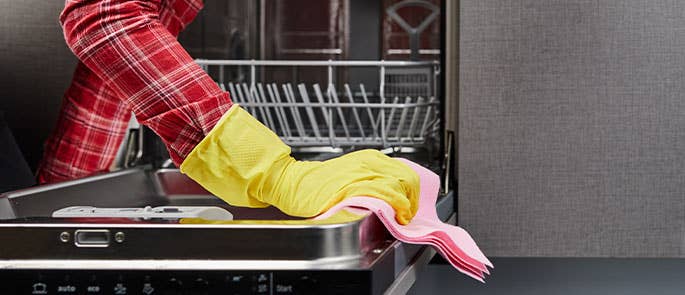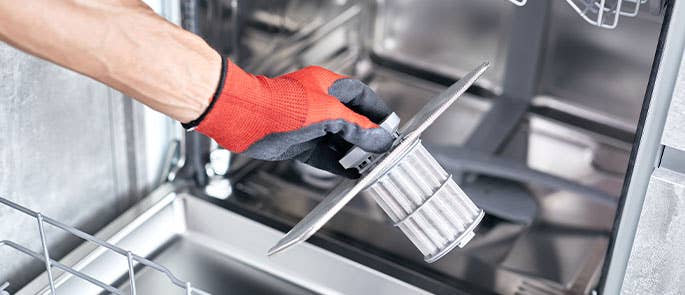How to Clean a Dishwasher
Keeping your dishwasher clean is essential for both hygiene and performance. Whether you use one at home or operate a commercial dishwasher in a professional kitchen, knowing how to clean it properly is vital to ensure it continues to operate effectively and dishes come out spotless. In this article, we’ll explain how to clean a dishwasher using various techniques, whether your dishwasher is at home or in the workplace.

Why Cleaning a Dishwasher is Important
A dishwasher may look clean on the surface, but food particles, grease and limescale can build up over time and affect how well your appliance performs. Residues can also lead to unpleasant smells or even blockages.
Cleaning a dishwasher is important for:
- Hygiene – regular cleaning prevents the spread of harmful bacteria and mould which can accumulate in warm, moist areas like filters and seals.
- Performance – a clean dishwasher cleans more effectively and uses water and energy more efficiently. For commercial dishwashers, which may run multiple cycles per hour, cleanliness directly impacts turnover speed and washing quality.
- Odour – removing trapped food particles and grease eliminates bad smells. This is particularly important in open-plan kitchens or serving areas.
- Longevity – keeping the interior, filter and spray arms free from debris helps avoid mechanical problems and extends the life of your machine. In a commercial kitchen, this can reduce maintenance costs and downtime.
- Legal compliance – for those working in catering or hospitality, a clean dishwasher is vital for meeting food hygiene standards and maintaining customer confidence.
How Often Should you Clean your Dishwasher?
To maintain your dishwasher’s performance, you should clean it regularly rather than waiting for problems to appear.
For domestic dishwashers, wipe down the door edges and seals and check the filter for trapped food particles once a week. Run a cleaning cycle with vinegar or a dishwasher cleaner once a month.
For commercial dishwashers in professional kitchens, inspect and wipe them down daily, checking filters and drains between shifts if the machine is used continuously. A deep clean using an approved descaler or sanitising agent should be scheduled weekly to maintain hygiene and prevent mineral buildup.

How to Clean a Dishwasher
There are several ways to clean your dishwasher: you can use natural cleaning agents, like vinegar, lemon and bicarbonate of soda, or opt for a chemical dishwasher cleaner. Most methods involve cleaning the removable parts first, then running a cycle with a cleaning solution to remove hidden grime.
For commercial dishwashers, always consult the manufacturer’s instructions before using cleaning chemicals to ensure compatibility with the components and stainless steel interiors.
How to Clean a Dishwasher Naturally
If you prefer to avoid chemical products, there are many effective, natural alternatives that can leave your dishwasher fresh and clean:
- Lemon – cut a lemon in half and place it on the top rack before running a short, hot cycle. The citric acid helps to break down grease and adds a pleasant scent.
- Vinegar – pour a cup of white vinegar into a dishwasher-safe bowl and place it on the top rack. Run a hot cycle to dissolve limescale and remove odours.
- Bicarbonate of soda – sprinkle a few tablespoons across the bottom of the dishwasher and run a short, hot cycle for extra freshness and stain removal.
- Soapy water – remove trays and racks and wash them in warm soapy water to get rid of residue. Do not put soap directly into the dishwasher as it can damage the machine.
Note: In commercial kitchens, natural cleaning methods may be used for daily maintenance, but approved sanitising agents are required for compliance with food hygiene regulations.
How to Clean the Dishwasher Filter
The filter is one of the most important components to clean regularly, as it traps food debris and prevents blockages. To clean the dishwasher filter:
- Remove the bottom rack to access the filter.
- Twist or lift the filter out carefully, following your manufacturer’s instructions.
- Rinse it under warm running water and use a soft brush to scrub away grease and trapped particles.
- Wash the surrounding area inside the machine with warm soapy water.
- Replace the filter securely before using the dishwasher again.
For commercial dishwashers, filters may need cleaning several times a day, depending on usage and the type of food being washed off. Always ensure filters are reinserted correctly to maintain water pressure and washing efficiency.
How to Clean the Dishwasher Drain
The drain sits beneath the filter and can collect grease or debris that causes slow drainage or odours. To clean the dishwasher drain:
- After removing the filter, inspect the drain area for trapped food or residue.
- Use a soft cloth or brush to wipe away visible dirt.
- Pour a mixture of bicarbonate of soda and vinegar down the drain, let it fizz for a few minutes, then flush with boiling water.
- Replace the filter and run a short rinse cycle to clear any remaining residue.
In commercial kitchens, use a degreasing agent suitable for catering appliances to prevent fat and oil build-up in the drainage system.
How to Clean the Inside of a Dishwasher
Once you’ve cleaned the filter and drain, it’s important to clean the rest of the interior of the dishwasher. To clean inside the dishwasher:
- Remove and wash the racks, utensil holders and spray arms with warm soapy water. Check that the spray holes are not blocked.
- Wipe the door seal and edges with warm soapy water to remove grease and mould.
- For commercial dishwashers, inspect the rinse and detergent nozzles and remove any visible limescale deposits.
- Place everything back inside and run a hot cycle with a dishwasher cleaner or vinegar to refresh the entire interior.
Dishwasher Cleaning Hacks
Even with regular care, you may encounter specific issues with your dishwasher, so here are some useful tips to tackle common dishwasher problems:
How to clean a smelly dishwasher 
Clean the filter and drain thoroughly, then run a hot cycle with vinegar or bicarbonate of soda. Leaving the door open after each wash helps prevent odours from returning. In commercial kitchens, end-of-shift ventilation and wiping down of seals are essential to prevent bacterial growth.
How to clean a stainless steel dishwasher 
Wipe the exterior with a soft cloth and mild detergent, then polish with a little olive oil or a dedicated stainless steel cleaner for a streak-free shine. This keeps both domestic and commercial machines looking spotless.
How to clean a clogged dishwasher 
Check the filter, spray arms and drain for food particles. A mixture of bicarbonate of soda and vinegar can help dissolve minor clogs, but persistent blockages may need professional attention, especially in high-use commercial machines.
How to clean hard water build-up in a dishwasher 
Limescale can leave cloudy marks on dishes, so use a limescale remover or run a cycle with vinegar once a month to prevent buildup. In hard water areas, commercial kitchens should install a water softener system for optimal results.
How to sterilise a dishwasher 
Run an empty cycle on the hottest setting with a cup of white vinegar or a dishwasher sanitising solution to kill bacteria and remove residue. Commercial machines often include built-in sanitising cycles that should be run at least daily.
Regularly cleaning your dishwasher keeps it hygienic, odour-free and running efficiently. Whether you use natural products at home or professional-grade cleaners in a commercial kitchen, maintaining your appliance properly will ensure your machine always performs at its best, as well as maintaining compliance with food hygiene regulations.
Further Resources:
- Food Hygiene Courses
- How to Clean a Fridge
- How to Clean a Microwave
- How to Clean a Blender
- How to Clean an Oven
- How to Clean an Air Fryer
- How to Load a Dishwasher







